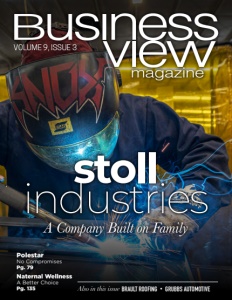Crothall Laundry and Linen Services
Unfolding a better experience
Business View Magazine interviews representatives from Crothall Laundry and Linen Services as part of our focus on the healthcare support sector.
Crothall Services Group, the parent company of Crothall Laundry Services, was formed in 1991 and is headquartered in Chesterbrook, Pennsylvania, just outside of Philadelphia. Crothall Services Group is a roughly 1.8-billion-dollar organization that provides healthcare support services to 1,600 healthcare clients in 41 U.S. states with just over 26,000 associates and a 98 percent retention rate. Among the services provided are: environmental services, patient transportation, clinical engineering, plant engineering, maintenance, and laundry & linens.
Crothall Laundry and Linen Services is the nation’s largest provider of healthcare laundry management and processing. Crothall processes over 630 million pounds of laundry per year to over 1,600 laundry customers throughout North America. With 17 plants and an additional 25 on-site management locations (about 42 locations across the country with annual capacities ranging from 300,000 pounds to 90 million pounds), Crothall is one of only two national providers in the U.S. Their main office is in Mooresville, North Carolina, about 35 miles north of Charlotte. The company has approximately 3,000 employees, nationwide.
Crothall was the first commercial laundry provider to eliminate phosphates and NPEs from its chemicals. Since 2007, Crothall Laundry Services has pursued voluntary accreditation for all of its laundry processing facilities from the Healthcare Laundry Accreditation Council (HLAC).
Business View Magazine recently spoke with Michael Barner, President of Crothall Laundry Services and Healthcare Technology Solutions; Division Vice President, Chris Corcoran; and Vice President of Strategic Accounts, Liz Remillong. The following is an edited transcript of that conversation.
BVM: Can you talk about the company’s origins and early days?
Barner: “We got into the laundry business in 1996, where we began our first management contract for an on-premise laundry that was a long-term healthcare customer in Georgia. We continued to grow from there through a series of management contracts, acquisitions, and greenfield expansions where we built our own plants. We entered into the hospitality market for laundry service in 2004, with Colonial Williamsburg in Virginia, expanded into Southern California in 2004, where we operate two locations today, and a further expansion into the hospitality market in 2007 with our first Ritz relationship, as we now operate a number Ritz-Carlton hotels around the country, today, for hospitality laundry.
“In 2008, we continued our expansion into Winston-Salem, North Carolina. We converted our relationship with a large healthcare system in the Charlotte area, taking over their laundry and converting it to a full-service laundry for ourselves. From there, we had some more rapid growth in 2011 when we did our first greenfield build – a plant in Oak Creek, Wisconsin, just outside of Milwaukee, a 70,000-square-foot facility built for a large healthcare customer in that marketplace. In 2012, we expanded into the Phoenix market with the acquisition of a large facility located near the airport in Phoenix that was previously owned by a competitor. In 2014, we did our second greenfield build expansion in Northern California in Manteca.”
“Healthcare is now the primary driver. The evolution in the growth of Crothall Laundry Services has been in healthcare, which represents 92 percent of the overall organization. Hospitality is interesting for us because of some marquee names, but the primary business for us is in healthcare.”
BVM: What characteristics would you point to that you feel give your company a competitive edge over the competition?
Remillong: “From my perspective, I think what gives us the edge is that we are very service-oriented. Not only do we provide hygienically-clean linen to our customers, but we get very involved with the hospitals once the linen hits the dock. We don’t just drop off and pick up. We’re there helping them, sharing best practices – how to utilize the linen, how to reduce their overall costs associated with linen and laundry services, helping them with distribution models. What differentiates us is that, where everybody says they do that, we actually have specific programs designed to go into hospitals and work with them, internally, in helping them reduce costs and use the linen in the best possible way.”
BVM: Can you talk more about the relationship between laundry services and the healthcare industry in the United States? And what changes are on the horizon, if any?
Barner: “Broadly speaking, this business is an essential service. Healthcare is an important part of the U.S. economy. The ability to have clean textiles is important for the delivery of care, making sure that there is the availability of the hygienically-clean linens, towels, scrubs, etc. We are bullish about the long-term viability of the industry. We are one of only two national players in the marketplace, but this has been, historically, very regional-based and/or mom-and-pop-based with family-owned laundries. In the past three to four years, we’ve seen an influx of private equity into the marketplace, and we believe we will continue to see private equity coming in that will see continued consolidation in order to drive efficiencies of scale and for folks to continue to be competitive in the space.
“This is different than what you would see in Canada or Europe, where you’ve got more state and central control on healthcare services. There’s 12 SKUs, and all the textiles are white, and there’s a higher level of automation. In the U.S., there’s still a lot more variety. However, we believe that continued automation will be critical on how we handle processing, how we manage delivery, and drive productivity within our plants.
“We think there’s a lot of it in the coming three to five years. We can continue consolidation in the marketplace, and that’s just what we’ve seen and what we believe will continue to happen. Then there’ll be continued drive for more automation in the marketplace, as well, to drive efficiency as a response to what are challenges in the labor market shortages.”
BVM: How do you go to market?
Barner: “In the world of healthcare, you’ve got large GPOs – the large group purchasing organizations. Vizient was a combination of VHA, University HealthSystem Consortium, Novation, and MedAssets’s Spend and Clinical Resource Management segment, including Sg2, to form the nation’s largest member-driven healthcare performance improvement company. Vizient has members that will participate with that GPO and those members are healthcare individual hospitals. We have a long-standing relationship with Vizient and a long-standing relationship with HealthTrust HPG, as well.
“So when we’re looking to go to market, we have partners, we have scale. We are one of the only national players in laundry, and are the largest player in environmental services, patient transportation, and facility services, and one of the largest in clinical engineering, as well. So we have a natural access into some of the largest healthcare systems in the country: the Kaisers, the Dignitys, the Sutters, the Mayos, or the Cleveland Clinics. So, Crothall Services serves the majority of the top healthcare systems across the country.
Remillong: “Not just as Crothall Laundry, but as Compass One Healthcare (the union of the Crothall and Morrison Healthcare Groups), we do have relationships with some of the large GPOs. Through those organizations, we become a part of the list and clients can reach out directly as members of those GPOs, so we get referrals through type of situations. A lot come through as hospitals are merging quite rapidly; we may do one system and not the other, so as the merger takes place, we’re afforded the opportunity to earn the business of the new partner of that facility. We do a lot of marketing as Compass One through different healthcare organizations. We belong to a lot of industry organizations, as well. Our partnerships with our vendors also bring us a lot of opportunity.”
BVM: What else would you like our readers to know about Crothall Laundry Services?
Barner: “I think you have to go beyond Crothall Laundry Services, first and foremost, when you’re talking about linen processing for healthcare. Giving the readership an understanding of the importance of the scale of healthcare linen processing is necessary because I don’t think there’s a lot of context. When we talk about Crothall Laundry Services, or laundry services for healthcare, people think of a typical laundromat and not football-field-size machinery processing 5,000 to 10,000 pounds of cloth per hour, doing so in a hygienically-clean state, where we send out our product after processing to labs who do independent tests on it to make sure that there is nothing bad within that linen, so it’s safe for those patients. Crothall will stand out and shine within the industry in that, but I think getting perspective on the broader service would be of value.
“I can tell you about the virtues of Crothall all day long. Personally, making sure folks understand the value of the service being provided generally is very, very important because it is a critical service for patients across the United States, and without it, patients aren’t going to get the care they need.”
Corcoran: “I think that’s the key. We believe in what we do. We recognize we are healthcare providers. Patients matter. Babies are born in our linen, and loved ones pass away in our linen, and we take that responsibility very seriously.”
Remillong: “We say, all the time, anybody can pick up dirty linen, wash it, and drop it off – which isn’t necessarily true; not everybody can do it – but not only do we do that well, but I think, as Chris alluded to, we also focus on the experience of what happens with that linen when it’s in the building, and take it a step further to understand that something that might seem insignificant in scope, when you’re talking about a new baby being born wrapped with one of your bath blankets, or a family around the bed as another member is suffering or passing, the linen is important. They don’t want to have issues with linen during those trying times, so we focus on the experience of what happens to that linen when it leaves the building and we spend a lot time, money, and energy trying to make sure that we can we provide the best experience for them that we can.”


